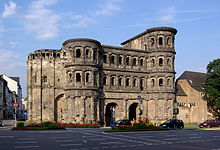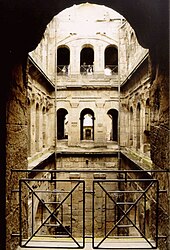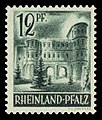Porta Nigra
The Porta Nigra ( Latin for "Black Gate") is an earlier Roman city gate built from 170 AD on Porta-Nigra-Platz and a symbol of the city of Trier . The name Porta Nigra comes from the Middle Ages. The residents of Trier usually only refer to the gate as "Porta".
The Porta Nigra has been part of the UNESCO World Heritage in Trier since 1986 . It is also a protected cultural asset under the Hague Convention . The Porta Nigra is the best preserved Roman city gate in Germany.
Edification
The construction of the city gate began in 170 AD as the northern entrance to the city of Augusta Treverorum ( Augustus city in the land of the Treverians ) . The dating of the gate has long been controversial and ranged from the 2nd to the 4th century AD. In January 2018, the start of construction based on a dendrochronological examination of wooden remains of the city wall was set to the year 170 AD, as these 169 / 170 had been felled.
In various places there are signs carved into the stones, some of which are upside down. These are probably stonemason's marks that help to reconstruct the construction of the gate. The signs in the west tower contain dates, but without the year, so that an absolute dating of the Porta Nigra is not possible in this way. However, the marks can be used to estimate the time it took to build the gate, as they marked several parallel blocks lying one above the other. If these times are extrapolated to the entire structure, taking into account a sensible subdivision into construction lots and excluding winter as the construction time, the Porta Nigra would have been completed as a shell within two to four years .
The construction begun under Emperor Marcus Aurelius was never finally completed . For example, the holes to accommodate the hinges of the gates have already been pre-made. However, the bosses of the unfinished cuboid still protrude into the axis of rotation of the gates , so that a movable gate could never be installed.
Even to the untrained eye, the porta makes an unfinished impression, for example the half-columns on the facade on the land side have been left in their raw state. The holes left by medieval metal robbers when they broke out the iron brackets and lead castings used in the construction for reuse add to this impression. A total of around 7200 stone blocks were used for the construction, the largest of which weigh up to six tons.
In the past it was often assumed that the Porta Nigra and the Roman city wall were built when northern Gaul was increasingly threatened by Germanic attacks in the 3rd century , the majority of researchers today believe that the building was a representative large-scale project which was not primarily intended for defense purposes and remained unfinished due to financial constraints.
In addition to the Porta Nigra on the north side of the city, there was the Porta Alba (White Gate) on the east side, Porta Media (Central Gate) on the south side and the Porta Inclyta (Famous Gate) on the Roman Bridge .
designation
The name Porta Nigra , which has been attested since the Middle Ages, is probably derived from the dark color that emerged from the weathering of the Kordeler sandstone . The name is mentioned for the first time in the Gesta Treverorum from the 12th century. The section reads in German translation: “They (the Treverians) named it Marstor after Mars , whom they saw as the god of war; when they went out to war, they marched out this gate. But it was called the Black Gate because of the sorrow in which they returned through it when they fled the field. ”The medieval author assumed that Trier was built by the Treverians in 203 BC, although the City was actually only founded by the Romans around 16 BC. The justification for the name of the gate, which the medieval author provides, in all likelihood arises only from the imagination. The term Porta Martis (Marstor) is also found for the first time in this text and was used as an alternative in the Middle Ages.
middle Ages
The Byzantine monk Simeon , who came from Sicily, settled in the building as a hermit after 1028. Allegedly he had let himself be walled in there. After his death in 1035 he was buried on the ground floor. The Archbishop of Trier, Poppo , obtained his canonization by the Pope in the same year. In honor of the saint, he built the Simeon monastery and rebuilt the gate to the double church , in whose lower chapel Simeon was buried. Some of the surviving monastery buildings date back to 1040. There have been created two superimposed church rooms, one of which still today apse can be seen. The organ room of the upper church on the west tower is still clearly visible. Since only one tower was needed to use the church, the second tower structure of the Porta Nigra was demolished. This is the only major change to the building fabric that has been visible to date.
The actual city gates of the Porta Nigra had been filled in, and a flight of stairs led to what is now the first floor of the building. The function of the city gate was taken over by the Simeontor, which connected directly to the Porta Nigra in the east. This gate, which is small compared to the Porta, was protected by the high fortification tower built in 1389, the so-called Ramsdonkturm.
Porta Nigra as Simeonskirche, engraving by Caspar Merian , 1670
Modern times
Napoleon had the church and the monastery abolished in 1802. During his visit to Trier in October 1804, he ordered the church extensions to be dismantled. From 1804 to 1809 the medieval building was gutted. The Prussians completed the demolition work from 1815, so that the Roman gate can now be seen again. Only the lower part of the medieval apse was left standing for monument preservation reasons. After the completion of the work, the building served as Trier's first museum of antiquities.
In the 1870s, the city wall and almost all of the medieval city gates were torn down, including the Simeon Gate.
On September 11, 1979, the Porta Nigra was symbolically occupied by opponents of nuclear power .
In 1986 the gate was added to the UNESCO World Heritage List , along with other Roman cultural monuments in Trier and the surrounding area .
Since 2005 the history of the Porta Nigra has been interpreted by an actor in the parade armor of a centurion as part of the Roman adventure tour “The Secret of the Porta Nigra” .
On January 27, 2014, a fire broke out in the east tower after two thirteen-year- olds threw fireworks from outside into a tower window and a curtain lit for a guided tour. The development of heat resulted in palm-sized flakes on a sandstone block.
reception
In 1921 the Porta Nigra was depicted on an emergency bank note from the city of Trier. In 1940 it first appeared on a postage stamp of the German Reich. In 1947 and 1948 there was a stamp with the Porta Nigra as a motif in Rhineland-Palatinate . A special postage stamp of the Deutsche Bundespost with a value of 80 Pfennig appeared on the occasion of the 2000 year celebration of Trier in 1984. In 2002 a new 1 euro long-term postage stamp of the stamp series Sights with Trier's Landmarks was issued. On February 3, 2017, a 2-euro commemorative coin received the Porta Nigra as a motif as part of the " Federal States Series " on the occasion of the Federal Council Presidency of the State of Rhineland-Palatinate (30 million copies).

|
A picture of the Porta Nigra can be seen in the coat of arms of the Rhineland-Palatinate command of the Bundeswehr . |

|
The logo of the football club Eintracht Trier also shows a picture of the Porta Nigra. |
literature
- Heinz Cüppers : The Romans in Rhineland-Palatinate. License edition, Nikol, Hamburg 2002, ISBN 3-933203-60-0 , section “Porta Nigra”, pp. 604–608.
- Sabine Faust: Guide to archaeological monuments in the Trier region (= series of publications by the Rheinisches Landesmuseum Trier. Volume 35). Rheinisches Landesmuseum Trier , Trier 2008, ISBN 978-3-923319-73-2 , section “Porta Nigra”, p. 56 f.
- Klaus-Peter Goethert: Roman buildings in Trier (= Edition Castles, Palaces, Antiquities Rhineland-Palatinate. Guide booklet 20). Schnell & Steiner, Regensburg 2003, ISBN 3-7954-1445-8 , section “Porta Nigra”, pp. 23–57.
- Peter Adolph Linde: The Porta Nigra and the Capitolium of the Treviris. Trier 1852, urn : nbn: de: 0128-2-17 .
- Lothar Schwinden: The Porta Nigra. In: Hans-Peter Kuhnen (ed.): The Roman Trier (= guide to archaeological monuments in Germany. Volume 40). Theiss, Stuttgart 2001, ISBN 3-8062-1517-0 , pp. 143-157.
Web links
- Website of the Porta Nigra
- Information about the Porta Nigra
- Image of the Porta Nigra in Roman times and after the gutting and images of the double church in the Middle Ages
- Entry for Porta Nigra in the database of cultural assets in the Trier region .
Individual evidence
- ↑ Karen Allihn: The Porta Nigra is really that old. In: FAZ.net , January 12, 2018.
- ↑ Entry on Roman city gates in Trier in the database " KuLaDig " of the Rhineland Regional Association , accessed on July 14, 2017.
- ↑ Update: Fire in the Porta Nigra cleared up. In: Wochenspiegel. January 27, 2014.
- ↑ 2017 - Rhineland-Palatinate: Porta Nigra (federal series). In: bundesbank.de
Coordinates: 49 ° 45 ′ 34.9 " N , 6 ° 38 ′ 38.5" E













